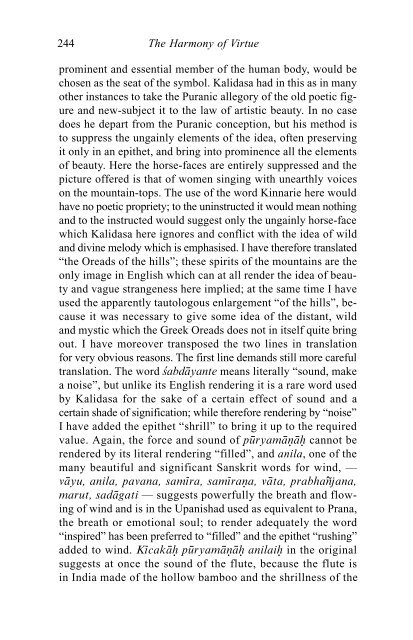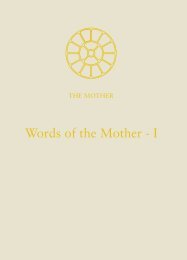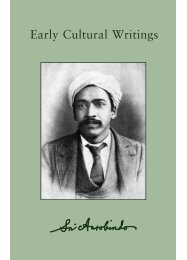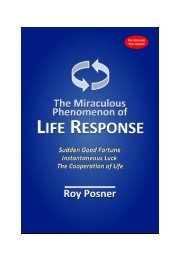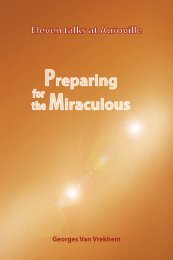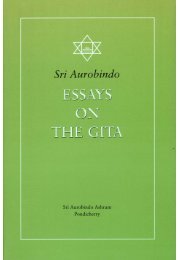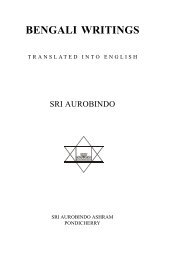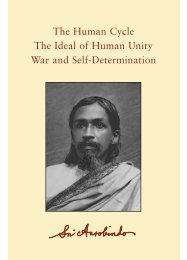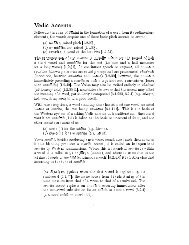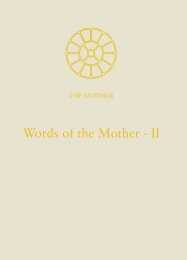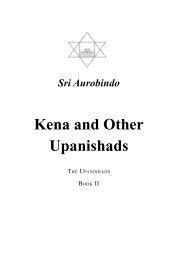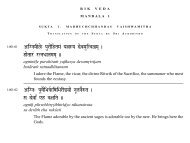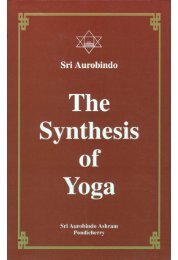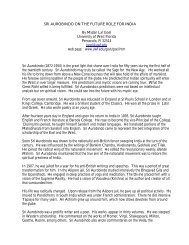- Page 2 and 3:
VOLUME 3SRI AUROBINDO BIRTH CENTENA
- Page 5:
Section OneTHE HARMONY OF VIRTUE189
- Page 8 and 9:
2 The Harmony of Virtuesomething di
- Page 10 and 11:
4 The Harmony of VirtueKeshav: And
- Page 12 and 13:
6 The Harmony of VirtueWilson: But
- Page 14 and 15:
8 The Harmony of Virtuephantasm spa
- Page 16:
10 The Harmony of Virtuemarriage an
- Page 20 and 21:
14 The Harmony of Virtuewho do not
- Page 22 and 23:
16 The Harmony of Virtuethird eleme
- Page 24 and 25:
18 The Harmony of VirtueWilson: The
- Page 26 and 27:
20 The Harmony of Virtueart was ris
- Page 28 and 29:
22 The Harmony of VirtueKeshav: And
- Page 30 and 31:
Book TwoKeshav Ganesh [Desai] — T
- Page 32 and 33:
26 The Harmony of VirtueKeshav: Why
- Page 34 and 35:
28 The Harmony of Virtuematerial co
- Page 36 and 37:
30 The Harmony of Virtuefrom savage
- Page 38 and 39:
32 The Harmony of Virtuehymns of pr
- Page 40 and 41:
34 The Harmony of Virtueto consider
- Page 42 and 43:
36 The Harmony of VirtueKeshav: Thi
- Page 44 and 45:
38 The Harmony of Virtuerose, a win
- Page 46 and 47:
40 The Harmony of Virtuedevelops th
- Page 48 and 49:
42 The Harmony of Virtueas a type i
- Page 50 and 51:
44 The Harmony of Virtueand indeed
- Page 52 and 53:
Book ThreeKeshav Ganesh [Desai] —
- Page 54 and 55:
48 The Harmony of Virtueand dangero
- Page 56 and 57:
50 The Harmony of VirtueKeshav: Bec
- Page 58 and 59:
52 The Harmony of Virtuethe elimina
- Page 60 and 61:
54 The Harmony of Virtueharmony of
- Page 62 and 63:
56 The Harmony of Virtuethe velvet
- Page 64 and 65:
58 The Harmony of VirtueWilson: Tha
- Page 66 and 67:
60 The Harmony of Virtueeyes, for i
- Page 68 and 69:
62 The Harmony of Virtuevirtuous bu
- Page 70 and 71:
64The Harmony of VirtueWe have expa
- Page 72 and 73:
66 The Harmony of Virtueretentive m
- Page 74 and 75:
68 The Harmony of Virtuewithout fea
- Page 76 and 77:
70The Harmony of Virtueducts for st
- Page 78 and 79:
72The Harmony of VirtueOne step bey
- Page 81 and 82:
ONEHis Youth and College LifeBankim
- Page 83 and 84:
II. 1. Bankim Chandra Chatterji77be
- Page 85 and 86:
II. 2. Bankim Chandra Chatterji79pa
- Page 87 and 88:
II. 2. Bankim Chandra Chatterji81ra
- Page 89 and 90:
THREEHis Official CareerTHUS equipp
- Page 91 and 92:
II. 3. Bankim Chandra Chatterji85Ma
- Page 93 and 94:
FOURHis VersatilityWHENEVER a liter
- Page 95 and 96:
II. 4. Bankim Chandra Chatterji89sa
- Page 97 and 98:
II. 5. Bankim Chandra Chatterji91Ba
- Page 99 and 100:
II. 5. Bankim Chandra Chatterji93fi
- Page 101 and 102:
SIXWhat He Did for BengalI HAVE kep
- Page 103 and 104:
II. 6. Bankim Chandra Chatterji97se
- Page 105 and 106:
SEVENOur Hope in the FutureBUT prof
- Page 107 and 108:
II. 7. Bankim Chandra Chatterji101o
- Page 109:
Section ThreeTHE SOURCES OF POETRYA
- Page 112 and 113:
106 The Harmony of Virtuegive us Sh
- Page 114 and 115:
108 The Harmony of Virtueinspiratio
- Page 116 and 117:
On Original ThinkingTHE attitude of
- Page 118 and 119:
112 The Harmony of Virtueenvironmen
- Page 120 and 121:
114The Harmony of Virtuethese imper
- Page 122 and 123:
116 The Harmony of Virtuethought-sy
- Page 124 and 125:
118 The Harmony of Virtuehas happen
- Page 126 and 127:
Social ReformREFORM is not an excel
- Page 128 and 129:
122 The Harmony of Virtuereformers.
- Page 130 and 131:
124The Harmony of Virtuestrength of
- Page 132 and 133:
126 The Harmony of Virtueutilitaria
- Page 134 and 135:
128 The Harmony of Virtueeducation
- Page 136 and 137:
Lecture in Baroda College*IN ADDRES
- Page 138 and 139:
132 The Harmony of Virtueand if you
- Page 141:
Section FourVALMIKI AND VYASA
- Page 144 and 145:
138The Harmony of Virtuebecause the
- Page 147 and 148:
NOTES ON THE MAHABHARATANotes on th
- Page 149 and 150:
IV. 2.Vyasa: Some Characteristics14
- Page 151 and 152:
IV. 2.Vyasa: Some Characteristics14
- Page 153 and 154:
IV. 2.Vyasa: Some Characteristics14
- Page 155 and 156:
IV. 2.Vyasa: Some Characteristics14
- Page 157 and 158:
IV. 2.Vyasa: Some Characteristics15
- Page 159 and 160:
IV. 2.Vyasa: Some Characteristics15
- Page 161 and 162:
IV. 2.Vyasa: Some Characteristics15
- Page 163 and 164:
IV. 2.Vyasa: Some Characteristics15
- Page 165 and 166:
IV. 2.Vyasa: Some Characteristics15
- Page 167 and 168:
IV. 2.Vyasa: Some Characteristics16
- Page 169 and 170:
IV. 2.Vyasa: Some Characteristics16
- Page 171 and 172:
IV. 2.Vyasa: Some Characteristics16
- Page 173 and 174:
IV. 2.Vyasa: Some Characteristics16
- Page 175 and 176:
IV. 2.Vyasa: Some Characteristics16
- Page 177 and 178:
IV. 2.Vyasa: Some Characteristics17
- Page 179 and 180:
IV. 2.Vyasa: Some Characteristics17
- Page 181 and 182:
IV. 2.Vyasa: Some Characteristics17
- Page 183 and 184:
IV. 2.Vyasa: Some Characteristics17
- Page 185 and 186:
The Problem of the MahabharataTHE P
- Page 187 and 188:
IV. 3. The Problem of the Mahabhara
- Page 189 and 190:
IV. 3. The Problem of the Mahabhara
- Page 191 and 192:
IV. 3. The Problem of the Mahabhara
- Page 193 and 194:
IV. 3. The Problem of the Mahabhara
- Page 195 and 196:
IV. 3. The Problem of the Mahabhara
- Page 197 and 198:
IV. 3. The Problem of the Mahabhara
- Page 199 and 200: IV. 3. The Problem of the Mahabhara
- Page 201 and 202: IV. 3. The Problem of the Mahabhara
- Page 203 and 204: 2THE problem of the Mahabharata, it
- Page 205 and 206: IV. 3. The Problem of the Mahabhara
- Page 207 and 208: IV. 4. Notes2017. The simile is str
- Page 209 and 210: IV. 4. Notes203as a modern English
- Page 211 and 212: IV. 4. Notes20523. Yateyureva — w
- Page 213 and 214: Udyogaparva*LET the reciter bow dow
- Page 215: IV. 4. Notes209what can you decide
- Page 219 and 220: KalidasaONCE in the long history of
- Page 221 and 222: V. 1. Kalidasa215Gujarat and Sindh
- Page 223 and 224: The Age of KalidasaVALMIKI, Vyasa a
- Page 225 and 226: V. 2. The Age of Kalidasa219existin
- Page 227 and 228: V. 2. The Age of Kalidasa221orgiast
- Page 229 and 230: V. 2. The Age of Kalidasa223intelle
- Page 231 and 232: V. 2. The Age of Kalidasa225culture
- Page 233 and 234: V. 2. The Age of Kalidasa227used es
- Page 235 and 236: The Historical MethodOF Kalidasa, t
- Page 237 and 238: V. 3. The Historical Method231phras
- Page 239 and 240: V. 3. The Historical Method233deduc
- Page 241 and 242: V. 3. The Historical Method235age w
- Page 243 and 244: V. 4. On Translating Kalidasa237vol
- Page 245 and 246: V. 4. On Translating Kalidasa239to
- Page 247 and 248: V. 4. On Translating Kalidasa241But
- Page 249: V. 4. On Translating Kalidasa243Are
- Page 253 and 254: V. 4. On Translating Kalidasa247qui
- Page 255 and 256: V. 4. On Translating Kalidasa249Ol.
- Page 257 and 258: V. 5. Kalidasa's “Seasons”251a
- Page 259 and 260: V. 5. Kalidasa's “Seasons”253co
- Page 261 and 262: V. 5. Kalidasa's “Seasons”255po
- Page 263 and 264: V. 5. Kalidasa's “Seasons”257a
- Page 265 and 266: V. 5. Kalidasa's “Seasons”259
- Page 267 and 268: Vikram and the Nymph“VIKRAM and t
- Page 269 and 270: Kalidasa's CharactersI. PururavasPU
- Page 271 and 272: V.. 7. Kalidasa's Characters265arti
- Page 273 and 274: V.. 7. Kalidasa's Characters267self
- Page 275 and 276: V.. 7. Kalidasa's Characters269he h
- Page 277 and 278: V.. 7. Kalidasa's Characters271but
- Page 279 and 280: V.. 7. Kalidasa's Characters273of t
- Page 281 and 282: V.. 7. Kalidasa's Characters275of r
- Page 283 and 284: V.. 7. Kalidasa's Characters277what
- Page 285 and 286: V.. 7. Kalidasa's Characters279in a
- Page 287 and 288: V.. 7. Kalidasa's Characters281by P
- Page 289 and 290: V.. 7. Kalidasa's Characters283atti
- Page 291 and 292: V.. 7. Kalidasa's Characters285Arth
- Page 293 and 294: V.. 7. Kalidasa's Characters287emba
- Page 295 and 296: V.. 7. Kalidasa's Characters289agai
- Page 297 and 298: IV. ApsarasThere is nothing more ch
- Page 299 and 300: V.. 7. Kalidasa's Characters293supr
- Page 301 and 302:
V.. 7. Kalidasa's Characters295sudd
- Page 303 and 304:
V.. 7. Kalidasa's Characters297sing
- Page 305 and 306:
V.. 7. Kalidasa's Characters299Hind
- Page 307 and 308:
V.. 7. Kalidasa's Characters301that
- Page 309 and 310:
V. 8. Hindu Drama303all must melt a
- Page 311 and 312:
V. 8. Hindu Drama305savage and half
- Page 313 and 314:
V. 8. Hindu Drama307enormous than t
- Page 315 and 316:
V. 9. Skeleton Notes on the Kumaras
- Page 317 and 318:
V. 9. Skeleton Notes on the Kumaras
- Page 319 and 320:
V. 9. Skeleton Notes on the Kumaras
- Page 321 and 322:
V. 9. Skeleton Notes on the Kumaras
- Page 323 and 324:
V. 9. Skeleton Notes on the Kumaras
- Page 325 and 326:
V. 9. Skeleton Notes on the Kumaras
- Page 327 and 328:
V. 9. Skeleton Notes on the Kumaras
- Page 329:
V. 10. A Proposed Work on Kalidasa3
- Page 333 and 334:
The Brain of IndiaTHE time has perh
- Page 335 and 336:
VI. 1. The Brain of India329inrush
- Page 337 and 338:
VI. 1. The Brain of India331the anc
- Page 339 and 340:
VI. 1. The Brain of India333we can
- Page 341 and 342:
VI. 1. The Brain of India335this re
- Page 343 and 344:
VI. 1. The Brain of India337teacher
- Page 345 and 346:
VI. 1. The Brain of India339common
- Page 347:
Section SevenFROM THE “KARMAYOGIN
- Page 350 and 351:
344 The Harmony of Virtuemost comma
- Page 352 and 353:
346The Harmony of Virtueof this dha
- Page 354 and 355:
348 The Harmony of Virtueciations w
- Page 356 and 357:
350 The Harmony of Virtuethey began
- Page 358 and 359:
The Greatness of the IndividualIN A
- Page 360 and 361:
354 The Harmony of Virtueteeth. In
- Page 362 and 363:
356The Harmony of Virtueforward ove
- Page 364 and 365:
358 The Harmony of Virtueof moral a
- Page 366 and 367:
360 The Harmony of Virtuevital poin
- Page 368 and 369:
The Stress of the Hidden SpiritTHE
- Page 370 and 371:
364 The Harmony of Virtueshapes it.
- Page 372 and 373:
The Strength of StillnessTHERE are
- Page 374 and 375:
368The Harmony of Virtuewhere activ
- Page 376 and 377:
370 The Harmony of Virtuesource and
- Page 378 and 379:
372 The Harmony of Virtueplaymates
- Page 380 and 381:
Man-Slave or Free?THE exclusive pur
- Page 382 and 383:
376 The Harmony of Virtuecome to th
- Page 384 and 385:
378The Harmony of Virtuefrom which
- Page 386 and 387:
380 The Harmony of Virtueand Hindui
- Page 388 and 389:
382The Harmony of Virtuein causalit
- Page 390 and 391:
384 The Harmony of VirtueHe does no
- Page 392 and 393:
386The Harmony of VirtueVedantist b
- Page 394 and 395:
388 The Harmony of Virtuethe strong
- Page 396 and 397:
390 The Harmony of Virtueact of fai
- Page 398 and 399:
392The Harmony of VirtueYoga is the
- Page 400 and 401:
394 The Harmony of Virtueand Mr. St
- Page 402 and 403:
396 The Harmony of Virtueonly by su
- Page 404 and 405:
Stead and MaskelyneTHE vexed questi
- Page 406 and 407:
400 The Harmony of Virtueand not at
- Page 408 and 409:
HathayogaTHE evolution of man has b
- Page 410 and 411:
404 The Harmony of Virtuevisible in
- Page 412 and 413:
RajayogaMAN fulfilling himself in t
- Page 414 and 415:
408 The Harmony of Virtuewill deal
- Page 417:
Section EightART AND LITERATURE
- Page 420 and 421:
414 The Harmony of Virtueor upward
- Page 422 and 423:
416The Harmony of VirtueThe Indian
- Page 424 and 425:
418 The Harmony of Virtuetakes them
- Page 426 and 427:
420The Harmony of VirtueWhether his
- Page 428 and 429:
422 The Harmony of Virtuetion a sin
- Page 430 and 431:
424 The Harmony of Virtueshoulder h
- Page 432 and 433:
Indian Art and an Old ClassicWE HAV
- Page 434 and 435:
428 The Harmony of Virtuethis perio
- Page 436 and 437:
Suprabhat: A ReviewTHE paper Suprab
- Page 438 and 439:
432 The Harmony of Virtuegiven are
- Page 441:
Section NinePASSING THOUGHTS
- Page 444 and 445:
438 The Harmony of VirtueEuropean e
- Page 446 and 447:
Stray Thoughts and GlimpsesTRUE her
- Page 448 and 449:
442 The Harmony of VirtueIIThe glor
- Page 450 and 451:
444 The Harmony of VirtueIIIMankind
- Page 452 and 453:
Academic ThoughtsThe Object of Gove
- Page 454 and 455:
448 The Harmony of Virtuetorture, h
- Page 456 and 457:
OneThings Seen in SymbolsWHAT is dh
- Page 458 and 459:
TwoThings Seen in SymbolsTHERE are
- Page 460 and 461:
OneEpistles from AbroadDearly belov
- Page 462 and 463:
456 The Harmony of Virtuewe become.
- Page 464 and 465:
TwoEpistles from AbroadFriend and B
- Page 466 and 467:
460The Harmony of Virtuecarry one's
- Page 468 and 469:
462 The Harmony of Virtuethe tempor
- Page 470 and 471:
In the Society's ChambersProfessor:
- Page 472 and 473:
466 The Harmony of VirtueWhoever in
- Page 474 and 475:
468 The Harmony of VirtueAt the Soc
- Page 476 and 477:
470 The Harmony of Virtueintimacy.
- Page 478 and 479:
472The Harmony of Virtueyou can dro
- Page 481 and 482:
OneDinshah - PerizadeD INSHAHPeriza
- Page 483 and 484:
TwoTuriu — UriuT URIUGoddess Leda
- Page 485 and 486:
X. Conversations of the Dead479U RI
- Page 487 and 488:
X. Conversations of the Dead481M AZ
- Page 489 and 490:
FourShivaji-Jai SinghJ AI SINGHNeit
- Page 491 and 492:
X. Conversations of the Dead485S HI
- Page 493 and 494:
X. Conversations of the Dead487out
- Page 495 and 496:
BIBLIOGRAPHICAL NOTETHE HARMONY OF
- Page 497 and 498:
NOTES ON THE MAHABHARATAVyasa: Some
- Page 499:
C ONTENTSSECTION TENCONVERSATIONS O


